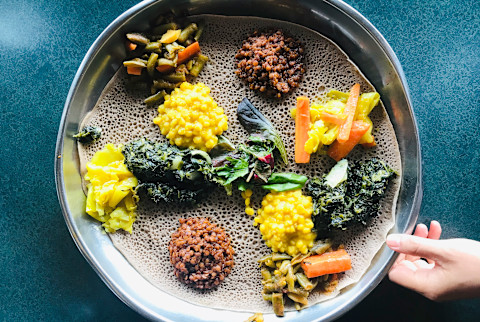5 African Superfoods & Their Unmatched Nutrients, From A Nutrition Specialist

Many people add kale, acaí, legumes, and chia seeds to their diets in order to increase their intake of superfoods. While all of those contain powerhouse nutrients, certified nutrition specialist and behavior coach Esosa Edosomwan, M.S., CNS, LDN, says they've got nothing on African superfoods.
In this Q&A with Esosa, mbg had the chance to learn about some of her favorite African superfoods, their health benefits, and the best ways to add them to a daily diet.
The list could probably go on and on, but for the sake of your time, which African superfoods are your top 5?
My No. 1 is definitely moringa (Moringa oleifera). I was introduced to it when I was in Ghana and met moringa farmers.
Some small-scale studies have actually tested moringa as a treatment for malnutrition1 in some African villages. The benefits are just potent. It could be a whole entire multivitamin on its own.
What are the health benefits of moringa?
Moringa contains 92 nutrients, 46 antioxidants, and all of the essential amino acids. It has seven times the vitamin C of oranges, three times the potassium of bananas, four times the calcium in milk, and four times the vitamin A in carrots.
The benefits go beyond nutrition, too. I put moringa oil on my face twice a day because who wouldn't want all those nutrients on their skin?
How do you use moringa outside of your skin care routine?
I will add moringa to my smoothies, essentially the same way I would add a greens powder.
I also make a superfood gluten-free bread with almond flour, tapioca flour, a little bit of salt, a chia egg, chlorella powder, moringa powder, and Everything but the Bagel seasoning from Trader Joe's, because it's lit—that will make everything taste good.
The moringa powder turns the bread green, and it tastes just as good as it would without it, but now I have all these added nutrients. Sometimes I'll make a pizza crust that way, too, then top it with pesto and a ton of green vegetables. I wouldn't put it in anything sweet, ever, but you can sprinkle it onto pasta or other savory meals for added nutrients.
That sounds amazing. So what's next on your list?
No. 2 would be baobab. Oh, it's so cool, they call it the tree of life, and these trees can take up to 15 to 20 years to bear fruit. There are baobab trees that have been on this earth for thousands of years, so you're basically getting ancient nutrition.
The fruit is football-shaped, and when you crack it open, it has an interesting consistency that can be ground into a powder. It contains about 50% prebiotic fiber, which is really important for maintaining the proper balance of good gut flora. It also has vitamin C, potassium, and minerals.
Baobab has a tart taste, so I usually mix it into my fruit smoothies, or an acaí or dragon fruit smoothie bowl. I would never put it in a cacao smoothie or anything that doesn't complement the tart flavor. It's also great mixed into orange juice for added vitamin C.
Are there any grains on the list?
Yes. No. 3 would be teff, which has vitamin A, B vitamins, vitamin C, and vitamin K. It contains a ton of iron and calcium—I find I crave it around my cycle because it provides nutrition that's actually really good for a menstruating person.
It's also rich in minerals like phosphorus, magnesium, potassium, and all of the essential amino acids. It's 20 to 40% resistant starch, which makes it gut-friendly, and it's gluten-free in its natural state.
If you go to an Ethiopian restaurant and you order gluten-free injera—which is actually the original kind that people eat in Ethiopia—that will be made from 100% teff. If it's not gluten-free, it's usually mixed with wheat flour, so you don't get the full benefits.
So, teff is often used as a flour. Is there anything that can be added to a grain bowl?
Lately, I've come to enjoy fonio. It's similar to quinoa or couscous, but it tastes more like couscous to me. It only takes about five minutes to cook, which is amazing.
Fonio contains B vitamins, including B12, which is not found in vegetables. It also contains about 12 grams of protein per cup, so that and the B12 make it a great addition to plant-based or vegan diets. It also contains minerals like magnesium and zinc in trace amounts. I generally enjoy it as a side dish or as the base for a grain bowl.
Last but not least, what's No. 5 on your list?
I would say hibiscus. If you look around the African diaspora and in Africa, you will notice that this hibiscus drink keeps popping up with different names. I learned about it as bissap, but others refer to it as zobo or sobolo. It has different names for different regions, but it's all the same.
Hibiscus is a diuretic2; it can lower blood pressure3, improve digestion, and it's anti-inflammatory. Sometimes, people put a ton of sugar in their hibiscus drink, which is probably not the best way to get all the benefits, but it still has medicinal properties. I find it fascinating that you can find West Indian folks who know about it and people from other regions of African who consider it a staple.
This interview has been edited and condensed for clarity.
